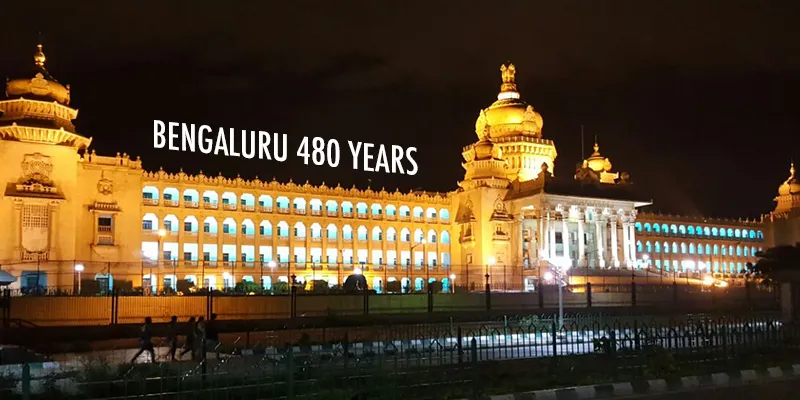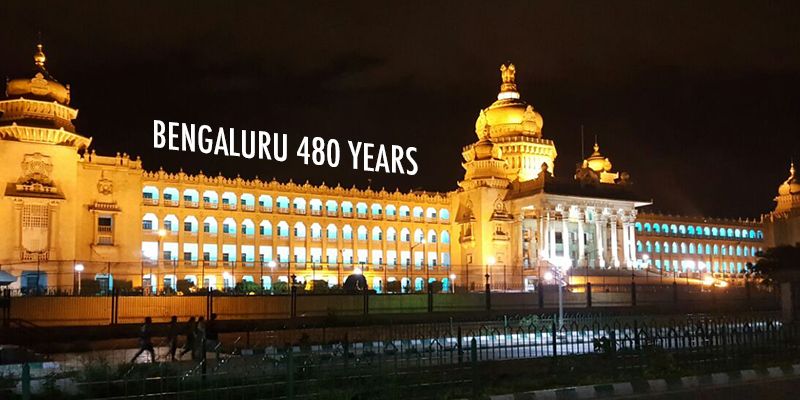Bengaluru plans big birthday bash as it turns 480 next year
Bengaluru will turn 480 years old next year, and the Karnataka government has planned a huge celebration that will pay tribute to the city’s history, culture and heritage.

The city’s founder Kempe Gowda’s original 5.5 km radius pete or market area will be spruced up and all neglected historical monuments will be restored to their original glory.
The pete areas of Chickpet, Akkipet, Tarugpet and others, each market known by what it sells, was designed into neatly divided blocks so many years ago. The bustling areas are now witness to severe congestion. To the confused, these pete areas are the narrow bylanes off Avenue Road, once the main artery of the city centre.
Legend has it that Kempe Gowda I (1510-1570), who was a chieftan, chose this location to build the city and called it Bendakaaluru - named after the boiled beans or benda kaalu that were famous here. He laid the foundation of the city as it is now by planning the petes. He also built the city’s fort, made of mud, in 1537.
The town had two main streets - Chikkapete Street that ran from east to west and Doddapete Street that ran from north to south. Their intersection formed the Doddapete square, currently what is referred to, in an anglicised way, as Chickpet circle.
Kempe Gowda’s successor, Kempe Gowda II, built temples, tanks and four watch towers that marked the city’s boundaries. The four watch towers, built in the then architectural style, had four stone pillars that supported a gopura or mandap. The watch towers are still in their original places and can be seen at Lalbagh on a hillock near the north gate off KH Road, near Kempambudhi tank in Majestic, near Ulsoor lake and at Mekhri circle. Of course, today the city has grown far beyond the pillars in a radial and undeveloped fashion.
Karnataka’s Tourism Minister Priyank Kharge announced that the entire pete area, encompassing a 5.5 km radius from Chickpet circle, will be spruced up, and neglected monuments relating to the founder, lying at various spots around the city, will also be restored. The Bengaluru fort, built in 1537, was improved upon by Tipu Sultan in the 17th century by reinforcing it with stone blocks to stave off the British, who made many attempts to take over his territory.
Kharge said it was strange that a city with 480 years of history was not celebrating its rich culture, heritage and history. "A city such as New York has so much branding while Bengaluru has none. We want people to go around wearing 'I Love Bengaluru’ t-shirts here and feel proud to belong to the city. There is also a plan to come up with souvenirs celebrating the city. It could be anything – from mugs to t-shirts to replicas commemorating the city’s heritage.’’
Quoting the centre’s 2015 statistics, Kharge said 110 million domestic tourists and 6.4 million foreigners visited Bengaluru, and except for the famed Mysore silks and Channapatna toys, there was nothing more the city could offer as a souvenir. He told YourStory,
Even if 25 percent of the 18 million air passengers spend one day visiting tourist spots around the city, a total of $450 million can be generated. Another way of looking at it is that even if 10 percent, or 1.8 million air travellers, spend Rs 200 per head for city souvenirs, it can enrich Bengaluru’s economy by Rs 36 crore per annum.
Related watch: [Video Story] Is China-patna pushing Channapatna toys out?
Cities across the world are celebrated for their culture, heritage and history, and, of course, for their resilience. Bengaluru, despite being 479 years old, is a city that has no ownership. "That no one has taken ownership of the city is a complaint we often hear, but what is anyone’s contribution towards retaining it?’’ asks Kharge who now plans to brand Bengaluru. With a population of less than 48 percent local Kannadigas residing here, it has become a cosmopolitan city and earned various tags such as Pensioners’ Paradise, Lake city, Pub City, IT City and other not-so-complementary sobriquets.
Towards this branding exercise, he has created a Bengaluru Tourism Advisory Committee chaired by the minister himself and including the Principal Secretary, Tourism and the Director of Tourism, while the other members are Subir Hari Singh of IHCN, urban expert V. Ravichander, urban landscape and planning expert Naresh V. Narasimhan, legal expert Siddhartha Raja, hospitality expert Sundar Raju, architect Narendra Pirgal and INTACH conservationist Satyaprakash Varanasi.
The committee has to prepare an action plan for developing the Bengaluru region as a global tourist destination, devise methods to increase the potential of tourism to develop the local economy and employment generation, identify circuits and trails (that cover pilgrimage, heritage, wildlife, adventure and colonial trails), suggest ideas on creating souvenirs and merchandising products for Bengaluru, explore the use of technology and promote various ideas such as festivals, art and culture to enhance brand Bengaluru.
The committee will have to submit its report in three months and come up with quick action plans for developing Bengaluru that will drive tourism, thus making Bengaluru a smart global city.
You may also like: Karnataka’s GDP loss from bus strike could touch Rs 100cr






